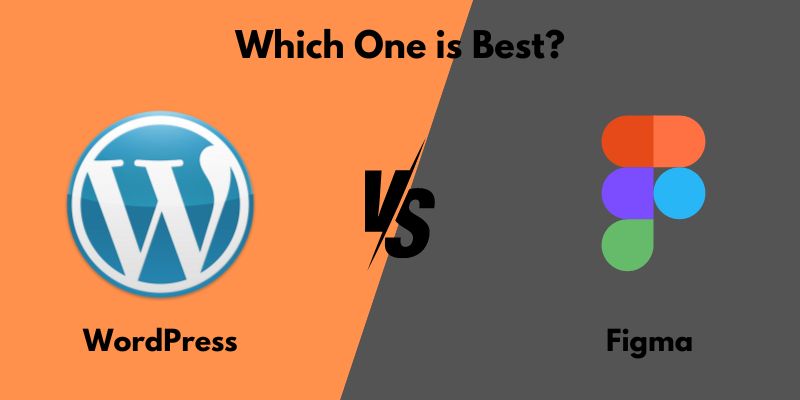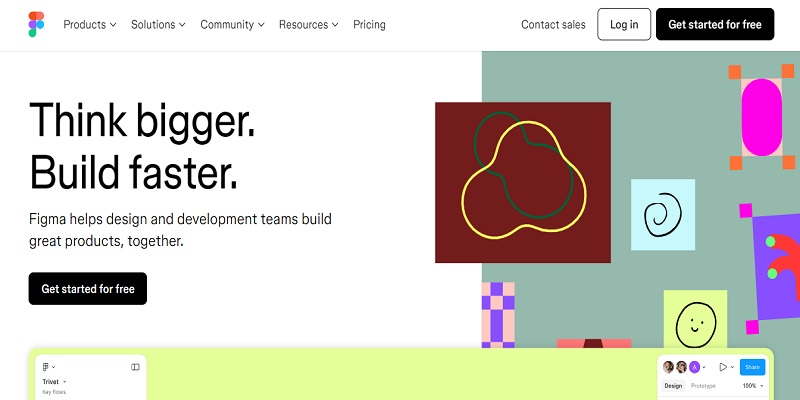
WordPress vs Figma: Which One is Best?
A Comprehensive Comparison
In a sea of options, WordPress vs Figma are two of the leading tools in their respective worlds of web building and design. Moreover, while both these tools have different purposes, web designers, developers, and digital marketers aim to understand how each one works, its strengths, and its weaknesses. However, the article speaks about the general role of WordPress and Figma and then goes in-depth to describe their features to help you decide which tool best suits your needs.
1. Introduction to WordPress and Figma
To make a detailed comparison between WordPress and Figma, a person should clearly understand what WordPress and Figma are used for.
WordPress

WP is a Content Management System or simply CMS powering over 40% of all websites on the internet. From its humble beginnings back in 2003 as a simple blogging platform, WordPress is now dynamic and multifunctional for building and handling websites. It hosts absolutely a great deal of themes, plugins, and other modification options that help one create any type of website blog, a personal website, an e-commerce website, and so on.
Figma

Figma is cloud-based software that allows collaboration in interface design. Launched in 2016, it instantly won the hearts of UI/UX designers with its powerful design functions, real-time collaboration capabilities, and ease of use. Designers widely use Figma for designing user interfaces, creating wireframes, prototyping, and user testing.
Now, allow me to take you through the real differences and similarities between WordPress and Figma across various parameters.
2. Purpose and Core Functionality
The main differences come in the form of what WordPress and Figma were developed for and their core functionality.
- WordPress: WP enables some building and managing of websites. Moreover, It is a Content Management System that allows the user to create and manage content, edit the site’s looks, and extend functionality with plugins and themes. WordPress enables functionality around what one could call content creation, publishing, optimization, and management of a website.
- Figma: It is a powerful vector graphics editor and prototyping tool, mainly used for designing digital interfaces. Moreover, with its functionality of vector editing, interactive prototyping, and real-time collaboration, designers can easily create visually appealing and user-friendly interfaces for websites and apps. Perceiving their focus, Figma targets design and user experience for digital products.
Where WordPress is about building the infrastructure of the website, Figma is about designing what that infrastructure will look and feel like, and how it will engage a user.
3. User Interface and Learning Curve
While easy to use, the design philosophy between WordPress and Figma must differ greatly since they serve very different purposes.
- WordPress: The WordPress interface is intuitively dashboard-based, with a myriad of menus for managing content, themes, plugins, and settings. In 2018, WordPress introduced the Gutenberg editor, which gave WordPress a block-based feel when creating content. Fairly quickly, this made it quite a lot easier for beginners to build and customize pages without requiring any coding knowledge. Still, to fully exploit the powers of WordPress, one usually needs to learn such things as themes, plugins, custom fields, and even sometimes basic coding in HTML, CSS, and PHP.
- Figma: It presents a clean and minimalistic interface focuses on design tools, such as the canvas, where designs are to be place and created; the toolbar, which will house all the different tools: pens, texts, and shapes among others; and also allows designers to handle via layers the positions of the elements of their design. However, its interface is intuitive to designers who have experience with other graphic design software like Adobe XD or Sketch.
For individuals experienced in UI/UX design, the Figma learning curve is pretty gentle. For complete novices who’ve never used any digital design tool before, however, it’s quite steep.
4. Features Comparison
To make more difference between WordPress and Figma, let’s delve into the key features of each:
WordPress Key Features:
1. Content Management: By nature, WordPress is a content management system design for content creation, editing, organization, and the management of posts, pages, images, and multimedia.
2. Themes and plugins: WordPress has thousands of free and paid-for themes and plugins to extend the functionality and customize it. It is very easy to change your site’s look and feel, and also extend the functionality.
3. SEO and Marketing Tools: WordPress is known for its SEO-friendly structure and the availability of numerous plugins like Yoast SEO that help optimize the content for search engines.
4. E-commerce Functions: Using plugins like WooCommerce, WordPress can serve as an extremely powerful e-commerce platform with ease.
5. User Administration: WordPress provides an extensible system of user role management that helps in granting different privileges to the users, for instance, administrator, editor, author, etc.
6. Security: There are a few security features directly available with WordPress, as well as some plugins to enhance its security, but much about security depends on the host and the user’s practices.
Figma Key Features:
1. Vector Editing: Figma boasts a powerful editor for vectors that will give designers the possibility to create scalable graphics and illustrations.
2. Interactive Prototyping: It offers users the ability to create prototypes that work like the final product through interactive presentations; thus, animation, transitions, and interaction features can be includ.
3. Real-Time Collaboration: Figma’s most powerful feature is the real-time collaboration feature, which enables many team members to collaborate on one design at the same time.
4. Design Systems and Libraries: You can create, care for, and manage design systems, component libraries, and reusable styles using Figma for reuse across projects.
5. Accessibility Across All Platforms: Since Figma is web-based, anything can be accessed regardless of the operating system used Windows, Mac, or Linux- and from any location.
6. Plugins and Integrations: Figma also allows for a checkmark in plugins and integrations into tools like Slack, Trello, and JIRA, extending much functionality within this tool.
5. Flexibility and Customization
Talking about flexibility and customization, both of these tools have their own merits.
- Flexibility with WordPress: With WordPress, one has a great deal of flexibility because it is open-source in nature. The thousands of available themes and plugins can be used to modify the appearance and extend the functionality of a site. Advanced users can customize core files and write custom code for bespoke sites. Also, WordPress supports a variety of content types, from blogs and portfolios to e-commerce stores and forums.
- Figma has a lot to say about flexibility: designers can actually create almost every UI element, prototype the interactions and animations, and even build complex design systems. Moreover, this collaboration in real-time is cloud-based and goes in the direction of making Figma that tremendous design team tool for rapid iterations and feedback. On the other hand, Figma does not extend its flexibility to website creation or management in general, but only to design.
6. Teamwork and Collaboration
While WordPress and Figma both can have collaboration in mind, the context is indeed different.
- WordPress Collaboration: You can assign user roles and permissions in WordPress, which allow you to control access to your content and the administration of your website. Multiple users can utilize one website for their work; each user has a certain role designated, like Administrator, Editor, Contributor, and so forth. However, collaboration itself in WordPress is usually asynchronous; the nature of the platform doesn’t fit real-time collaboration over content or design.
- Figma Collaboration: Many team members can work simultaneously on any design while changes can also be viewed in real-time, with comments, and feedback. This feature makes it most suitable for design teams and remote work environments. Figma’s collaborative capabilities further extend past designers themselves to stakeholders and clients, who may also review and comment on designs, not themselves having to take out a Figma license.
7. Performance and Accessibility
- WordPress Performance: To determine the performance of a WordPress website, you must consider many factors, including the hosting provider, the theme, the plugins in use, and most importantly, how well the site is optimize. With proper optimization, caching, and a good hosting provider, WordPress websites can load fast and handle heavy traffic. Poor optimization or overuse of heavy plugins will slow down a site.
- Figma Performance: As a design tool hosted on the cloud, Figma is very dependent on internet connectivity and browser performance. It generally works out quite well, although it does creak at the seams when handling very big or complex files, and sometimes when internet speed is a factor. At the same time, its cloud-based nature offers the added benefit of accessibility from anywhere on any device with a modern browser, providing incredible flexibility for remote work.
8. Cost and Pricing
Cost is of big concern for small businesses, startups, and freelance creators.
- WordPress Cost: While WordPress itself is free and open-source, running a website on WordPress requires some cost for domain registration, hosting, premium themes, and plugins. Large differences can appear in the total cost since it directly connects with the complexity of the website and, consequently, the services required. WordPress provides enormous flexibility from the cost perspective; hence, it could be used for small personal blogs and large enterprise websites.
- Figma Cost: Figma uses a subscription-based business model. It has a free plan available, which can be used by a single person or for small projects. Paid plans start at $12 per editor/month on the Professional plan, and Enterprise plans add unlimited projects, advanced prototyping, and design system management. There is also the Organization plan with advanced security and administrative features for $45 per editor/month.
Figma has found that balance in pricing, with relatively affordable services for design teams, though it may be expensive for solo designers on a tight budget.
9. Use Cases and Best Fit
Now, let’s look at their best use cases to get an understanding of which tool will serve you better:
WordPress Best Use Cases:
- Building and managing content-rich websites (blogs, news sites, etc.).
- Development of e-commerce stores using plugins like WooCommerce.
- Building custom websites with customized functionalities: membership sites, forums, etc.
- SEO and digital marketing website management and optimization.
Figma Best-use Cases:
- Designing user interfaces for websites, mobile apps, and other digital products.
- Design wireframes, mockups, and prototypes testable by users.
- Collaborate in real-time with design teams and stakeholders.
- Development and maintenance of design systems and component libraries.
10. Integration and Ecosystem
Integration with various tools and services is allow for both WordPress and Figma.
- WordPress Integration: With WordPress, one can integrate everything from email marketing applications like Mailchimp and ConvertKit to analytics such as Google Analytics, payment gateways like PayPal and Stripe, and many others. Moreover, API integrations will allow custom WordPress web development services and developers to connect WordPress with nearly any platform.
- Figma Integrations: Figma integrates with lots of various design and productivity applications, including Slack, Trello, Notion, JIRA, and many more. Further, it has plugin support to expand its capabilities, such as chart creation, stock photo importation, or design token generation. Potential integrations further Figma’s place in the workflow of designers, but they are limited to tools relevant to design and collaboration.
11. SEO and Marketing
Search Engine Optimization and digital marketing are extremely crucial to any website for its success, and WordPress a ranks high on that count.
- WordPress SEO: WordPress is inherently built for SEO. It allows its users to change meta, URLs, and alt texts, among others. Yoast SEO or Rank Math plugins enhance SEO further, providing suggestions on on-page optimization, creating XML sitemaps, and more. It integrates with other marketing tools and platforms for running extensive marketing campaigns using WordPress.
- Figma SEO: SEO and Marketing-Figma don’t support SEO and marketing directly, because by design it is not a constructor and website manager. “All the same, designers can use Figma to create an interesting and user-friendly interface that enhances user experience, indirectly improving SEO and conversion optimization.”
12. Security
- WordPress Security: Security is among the key concerns of every digital tool. Both WordPress and Figma look at securities in different ways. However, the security of WordPress greatly relies on hosting providers, plugins, and users’ practices. This demands a good hosting provider, the use of recent and secure plugins, keeping the site updated, and observation of best security practices such as strong passwords and SSL certificates. There is a multitude of security plugins with a set of features like malware scanning, firewall protection, and prevention of brute force attacks.
- Figma Security: In Figma, security is handled independently, including encryption of data, secure authentication, and periodic security updates. Being web-based, it relies on the security protocols of the hosting servers. For teams and organizations, it offers more advanced security features, including SSO or Single Sign-On, and advanced administrative functions in its higher-tier plans.
13. Future Trends and Developments
Both WordPress and Figma are evolving continuously, meaning regular updates and new features are being release.
- WordPress Trends: WordPress is on its way to smarter usability, led by the Gutenberg block editor, which was supposed to introduce an even easier and much more visual way of building pages. Moreover, Performance, security, and accessibility finally arrived on the table of the WordPress community, making WordPress more robust and increasing the variety of use cases it can offer.
- Figma Trends: Continuing to beef up its design and prototyping capabilities, Figma focuses on collaboration, design systems, and community-driven resources. Moreover, the platform regularly includes new features like enhanced auto-layout, advanced animations, and better integrations with other tools. Additionally, the ecosystem grows through the addition of plugins and new community resources, which is why many UI/UX designers consider Figma one of their primary tools.”
Conclusion
WordPress or Figma – Which to Choose?
Fundamentally, a choice would boil down to several aims you have and needs between WordPress and Figma:
Use WordPress if:
- You want to create and administer a fully-fledged website.
- You need a content management system because you have to create, publish, and SEO-optimize your content.
- You want an e-commerce site or a site with dynamic content.
- You want flexibility in terms of customization and scalability.
Choose Figma if
- You are focusing on designing user interfaces, prototypes, or mockups.
- You need something that will help you collaborate with design teams and stakeholders in real-time.
- You want to create a design system or maintain consistency across projects.
- You need a cloud-based design tool that works across all platforms.
Moreover, in other words, WordPress and Figma are indeed powerful tools in their respective domains. Many professionals use them together for design and WordPress for implementation to create compelling and functional digital experiences. However, given this knowledge of differences and strengths related to each tool, you can arrive at an informed decision for what will needlessly be accomplished by a project within your team’s workflow.
You can also read our related articles: